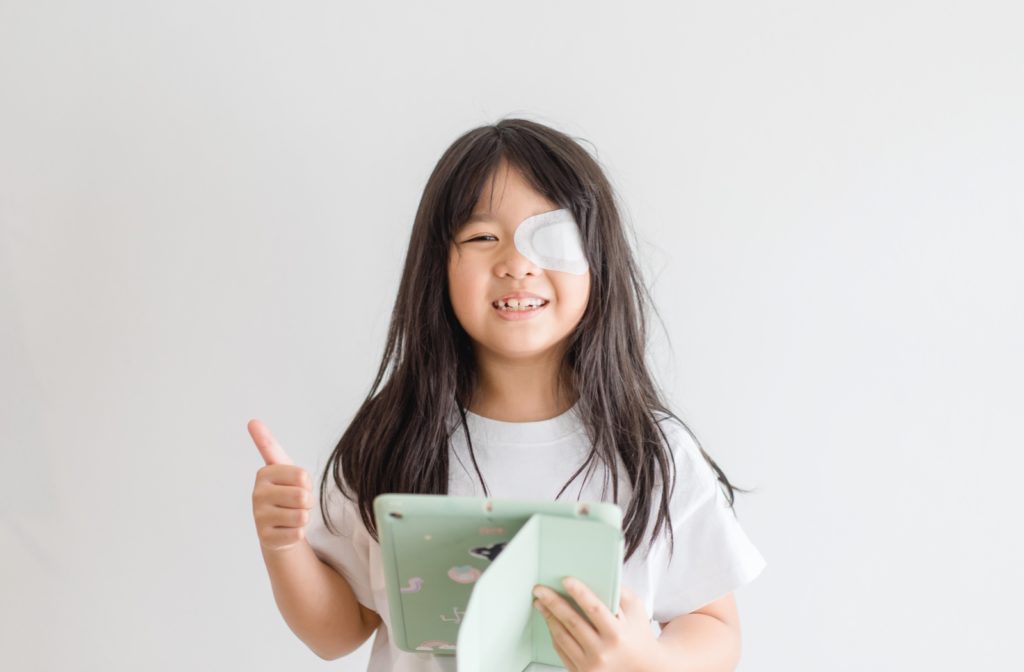What Is Too Late to Treat Lazy Eye?
It’s never too late to get treated for a lazy eye. There is a common misconception that lazy eyes are only treatable in children; however, this isn’t necessarily true. While lazy eye treatments are effective in children because of their ability to adapt quickly, some treatments can help reduce vision problems associated with lazy eye in adults.
It’s essential to understand what lazy eye is in the first place, including what causes lazy eye, and how an eye doctor can help develop an effective treatment plan to treat lazy eye, whether you’re an adult with a lazy eye or looking for treatment for your child.
What is Lazy Eye?
Amblyopia, more commonly known as lazy eye, occurs when one eye dominates the other, leading to diminished vision. This dominance is most often caused by one eye being weaker, so the other eye compensates for the vision problems in the other. This dominance can lead to even more severe vision problems in the weaker eye.
Usually, the two eyes take in separate images that the brain interprets into one coherent picture. With amblyopia, the brain relies on the one eye to take in visual information, which can lead to problems such as:
- Poor depth perception
- Blurry vision
- Squinting
Types of Lazy Eye
Not all lazy eyes are the same. There are a few distinct causes of lazy eye which can change the treatments your doctor recommends as part of a comprehensive treatment plan.
Strabismic Amblyopia
Strabismic amblyopia is caused when one of the eyes experiences strabismus. Strabismus, or crossed eyes, occurs when the 6 muscles that control eye movement don’t respond to input from the brain.
This condition causes a lazy eye to wander inward or outward due to the lack of control over eye muscles. This lack of control leads to an inability to focus. The brain usually compensates for this by ignoring the strabismic eye and concentrating solely on taking in information from the unaffected one.
Refractive Amblyopia
Refractive amblyopia is caused by a difference in the refractive errors between the two eyes. A refractive error can include:
- Nearsightedness (myopia)
- Farsightedness (hyperopia)
- Astigmatism
When the cornea isn’t correctly curved, it doesn’t refract light properly on the retina. This incorrect shape can cause blurry vision and an inability to focus at certain distances.
Usually, people only experience one refractive error, though each eye can have different prescriptions in some cases. A person could have myopia in one eye and hyperopia in the other. This difference can lead the brain to compensate and focus on one eye, usually the myopic one, leaving the other eye underused and leading to lazy eye.
Refractive amblyopia is less visually obvious than strabismic amblyopia and is usually diagnosed during a comprehensive eye exam.
Deprivation Amblyopia
Deprivation amblyopia is less common than strabismic or refractive amblyopia but can lead to the most severe vision outcomes. This condition is caused when an infant or child develops a cataract or has an opaque cornea.
When one eye is deprived of proper sight, it doesn’t develop properly and causes the brain to rely heavily on the other, leading to a lazy eye.

Is It Too Late for Lazy Eye Treatment?
Lazy eyes are most often diagnosed in children, and treatment usually follows. However, while early diagnosis and treatment can prevent other vision problems later on in life, treatments are still effective in adults to deal with those vision problems.
Our brains are powerful and able to adapt to many conditions, which is what causes lazy eye in the first place. Whether in a child over the age of 7 or in an adult, lazy eye treatment can be effective.
How Is Lazy Eye Treated?
There are a few treatment options available to those with lazy eyes. Your eye doctor can work with you or your child to determine which treatment option will work best based on the cause and severity of the lazy eye condition.
Vision Therapy
Vision therapy can help the eyes learn to work together by strengthening their connection and reducing the brain’s reliance on the non-affected eye. Vision therapy uses techniques to train the weaker eye to react, focus, and coordinate with the other eye to improve the vision problems associated with lazy eye.
Eyepatches
Eye patches are a valuable tool in lazy eye treatment. When we pace the eyepatch over the non-affected eye, it encourages the lazy eye to focus and can help strengthen muscle weakness associated with strabismic amblyopia.
Surgery
Surgical options are available for strabismic amblyopia. A surgeon can complete a recession to detach and reattach the eye muscle away from the eye or resection to remove the muscle. Surgery is not recommended if the eyes are aligned.
Prescription Lenses
Getting proper prescription lenses can correct a refractive error and reduce the brain’s reliance on one eye over the other. It’s essential to use the prescription lenses correctly every day to get the most out of the treatment, and visit an eye doctor to keep checking and adjusting the prescription.
Get in Touch with Us
It’s never too late to treat lazy eye. If you or your child require treatment for a lazy eye, get in touch with our team. We can recommend a treatment option after completing an eye exam and uncovering the exact cause of your lazy eye.



